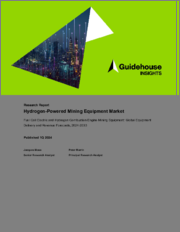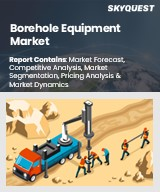
|
시장보고서
상품코드
1455658
세계의 수소 동력 광산 장비 시장 - 연료전지 전기 및 수소 연소 엔진 기반 광산 장비 : 장비 납품 및 매출 예측(2024-2033년)Hydrogen-Powered Mining Equipment Market - Fuel Cell Electric and Hydrogen Combustion Engine Mining Equipment: Global Equipment Delivery and Revenue Forecasts, 2024-2033 |
||||||
광업 기업은 비화석 에너지로의 전환에서 중요한 역할을 담당하고 있습니다. 광업은 청정 에너지 기술 생산에 필요한 원료를 제공하는 한편, CO2 배출원으로서도 중요한 역할을 하고 있습니다. 채굴 사업에서 배출되는 배출량의 절반 미만은 대형 채굴 차량과 장비의 디젤 소비로 인한 것입니다. 운반 트럭은 연간 약 6,800만 톤의 CO2를 배출하는 가장 큰 연료 사용자입니다.
세계 주요 광산 업체들은 대부분 기후 변화 전략을 발표했으며, 일반적으로 2040년대와 2050년대에 기후 중립 목표를 설정하고 운영 중 배출량을 목표로 삼고 있습니다. 광산 장비 및 파워트레인 공급업체와 협력하여 이들 기업은 현재 운반 트럭, 굴삭기, 로더, 굴착기, 굴착 장비 및 기타 현장 장비를 탈탄소화하기 위한 다양한 솔루션을 모색하고 있습니다. 대부분의 대체 경로와 달리, 수소는 채굴업체가 현장에서 연료를 생산하거나 제3공급업체로부터 연료를 조달할 수 있는 유연성을 제공합니다. 또한, 연료 충전 시간이 짧고, 출력 밀도가 높으며, 배터리 전기 솔루션보다 항속거리가 더 길 수 있습니다. 그러나 완전한 전기 경로에 비해 수소 기술의 왕복 효율이 낮기 때문에 일반적으로 운영 비용이 더 높습니다. 따라서 일부 예외적인 경우를 제외하고는 광산 업계 관계자들은 수소 기술에 대한 투자에 대해 신중한 태도를 보이고 있습니다.
이 보고서는 2024-2033년 세계 수소 동력 광산 장비 시장의 지역별, 장비 유형별, 파워트레인 기술별 판매량과 수익을 예측합니다. 또한, 광산 기업 및 장비 공급업체의 개요를 조사하고, 전기와 수소 동력 탈탄소화 경로의 트레이드오프 관계를 검토하고, 수소 기술 및 광업 가치사슬 전반의 이해관계자들에 대한 제안을 제공합니다.
목차
제1장 주요 요약
제2장 시장 문제
- 성장 촉진요인
- 성장 억제요인
- 에너지 전환에 의한 물질 수요 증가
- 광석 품질 저하에 의한 영향
- 채굴 작업에서의 배출원
- 파워트레인 기술
제3장 업계 밸류체인
- 장비 및 기술 제공업체
- 광산 기업
제4장 시장 예측
- 분석 방법
- 세계 시장 개요
- 수소 동력식 광산기계 : 지역별
- 수소 동력식 광산기계 : 장비 유형별
- 수소 동력식 광산기계 : 파워트레인 기술별
- 시장 예측 : 지역별
- 북미
- 유럽
- 아시아태평양
- 라틴아메리카
- 중동 및 아프리카
제5장 결론 및 제안
- 주요 요점
- 추천 사항
- 광산기계 제조업체
- 파워트레인 기술 제공업체
- 광산 기업
- 수소 프로젝트 개발자
- 정책 입안자
제6장 두자어 및 약어 리스트
제7장 목차
제8장 도표
제9장 분석 범위
제10장 정보원, 분석 방법, 주석
LSH 24.04.03Mining companies have an important role to play in the transition to non-fossil energy sources. While the industry provides the raw materials needed for the manufacture of clean energy technologies, it is also a significant source of CO2 emissions. A little under half of the emissions from mining operations come from diesel consumption in heavy duty mining vehicles and equipment. Haulage trucks are the largest fuel users, accounting for approximately 68 million tons of CO2 emissions per annum.
Most of the world's major mining players have released climate strategies, typically covering operational emissions with climate neutrality goals set for the 2040s and 2050s. Working in tandem with mining equipment and powertrain suppliers, these companies are currently exploring a range of solutions to decarbonize haulage trucks, excavators, loaders, drilling rigs, and other onsite equipment. Unlike most alternative pathways, hydrogen offers mining players the flexibility to produce fuel onsite or procure it from third-party suppliers. It also presents faster refueling times, increased power density and greater range potential than battery electric solutions. However, the low round trip efficiency of hydrogen technologies compared to fully electric pathways typically entails higher operational costs. With some notable exceptions, mining players are therefore taking a cautious approach to investing in hydrogen technologies.
This Guidehouse Insights report forecasts hydrogen-powered mining equipment sales and revenues from 2024-2033, segmented by global region, equipment type, and powertrain technology. It provides a detailed overview of mining players and equipment suppliers, discusses some of the tradeoffs between electrification and hydrogen-based decarbonization pathways, and offers recommendations to stakeholders across the hydrogen technology and mining value chains.
Table of Contents
1. Executive Summary
- 1.1 Market Introduction
- 1.2 Market Forecast
2. Market Issues
- 2.1 Drivers
- 2.2 Barriers
- 2.3 Increasing Material Demands from the Energy Transition
- 2.4 Impact of Declining Ore Grades
- 2.5 Sources of Emissions from Mining Operations
- 2.6 Powertrain Technologies
3. Industry Value Chain
- 3.1 Equipment and Technology Providers
- 3.2 Mining Companies
4.Market Forecasts
- 4.1 Methodology
- 4.2 Global Market Overview
- 4.2.1 Hydrogen-Powered Mining Equipment by Region
- 4.2.2 Hydrogen-Powered Mining Equipment by Equipment Type
- 4.2.3 Hydrogen-Powered Mining Equipment by Powertrain Technology
- 4.3 Regional Market Forecasts
- 4.3.1 North America
- 4.3.1.1 Hydrogen-Powered Mining Equipment by Equipment Type, North America
- 4.3.1.2 Hydrogen-Powered Mining Equipment by Powertrain Technology, North America
- 4.3.2 Europe
- 4.3.2.1 Hydrogen-Powered Mining Equipment by Equipment Type, Europe
- 4.3.2.2 Hydrogen-Powered Mining Equipment by Powertrain Technology, Europe
- 4.3.3 Asia Pacific
- 4.3.3.1 Hydrogen-Powered Mining Equipment by Equipment Type, Asia Pacific
- 4.3.3.2 Hydrogen-Powered Mining Equipment by Powertrain Technology, Asia Pacific
- 4.3.4 Latin America
- 4.3.4.1 Hydrogen-Powered Mining Equipment by Equipment Type, Latin America
- 4.3.4.2 Hydrogen-Powered Mining Equipment by Powertrain Technology, Latin America
- 4.3.5 Middle East & Africa
- 4.3.5.1 Hydrogen-Powered Mining Equipment by Equipment Type, Middle East & Africa
- 4.3.5.2 Hydrogen-Powered Mining Equipment by Powertrain Technology, Middle East & Africa
- 4.3.1 North America
5. Conclusions and Recommendations
- 5.1 Main Takeaways
- 5.2 Recommendations
- 5.2.1 Mining Equipment Manufacturers
- 5.2.2 Powertrain Technology Providers
- 5.2.3 Mining Companies
- 5.2.4 Hydrogen Project Developers
- 5.2.5 Policy Makers




















